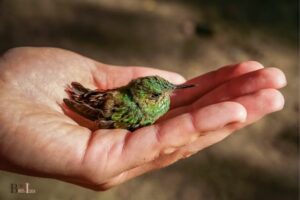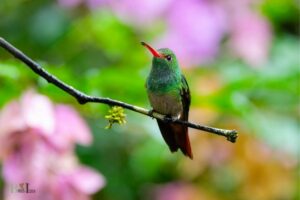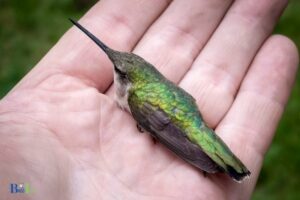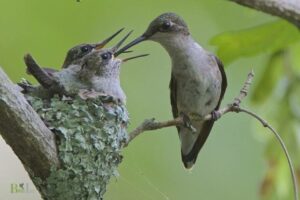How Did Anna’s Hummingbird Get Its Name: Name in Honor!
Anna’s Hummingbird got its name in honor of Anna Masséna, Duchess of Rivoli.
Anna’s Hummingbird (Calypte anna) is a medium-sized hummingbird native to the western coastal regions of North America.
It was named by the French naturalist René Primevère Lesson in 1829, in honor of Anna Masséna, Duchess of Rivoli, and wife of French ornithologist François Victor Masséna.
The Anna’s Hummingbird is a fascinating species, known for its vibrant, iridescent feathers and incredible agility in flight.
These birds are capable of rapid, agile movements, as well as hovering in place to feed on nectar, making them a popular subject for birdwatchers and nature enthusiasts alike.
The name of the bird serves as a tribute to Anna Masséna, a prominent figure in French society during the early 19th century.
1 Origin and Naming History of Anna’s Hummingbird
| Origin of Name | Named After | Discovered By | Year of Discovery | Scientific Name |
| Anna’s Hummingbird | Anna Masséna, Duchess of Rivoli | René-Primevère Lesson | 1829 | Calypte anna |
Key Takeaway
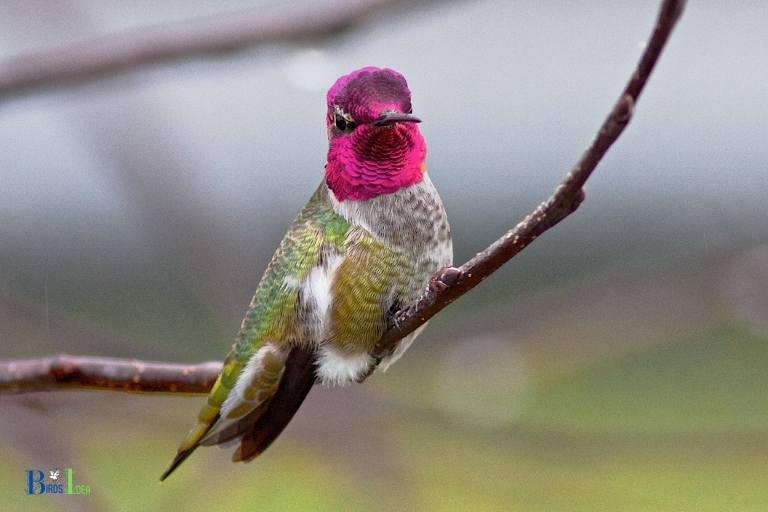
Five Facts About: Anna’s Hummingbird’s Name Origin
Origins And Description Of Anna’S Hummingbird
Anna’s hummingbird, scientifically known as calypte anna, is a small, brightly colored bird that is commonly found in north america.
The name of the bird is derived from anna masséna, the duchess of rivoli, who is said to have been an avid bird collector in the early 19th century.
Here are some key points about the physical characteristics, geographic distribution and habitat, and early observations and discoveries of anna’s hummingbird.
Physical Characteristics Of The Bird
- Anna’s hummingbird is 3.9 to 4.3 inches long and weighs around 0.1 to 0.2 ounces.
- The male bird has metallic green feathers on its head, back, and flanks. It has a shimmering rose-red throat, which is iridescent and shows different colors depending on the light. Its wings are narrow and pointed, and it has a short, straight black bill.
- The female bird has grayish-green feathers on its back and head, and a white breast with some green spotting. Its throat is pale, and it has a longer, curved bill than the male.
Geographic Distribution And Habitat
- Anna’s hummingbird is native to the west coast of north america, and is commonly found in california, baja california, and vancouver island.
- The bird can be found in a variety of habitats including gardens, chaparral, open woods, and oak savannahs. It is often seen in urban areas, especially in parks and gardens where feeders are available.
Early Observations And Discoveries Of Anna’S Hummingbird
- The first recorded sighting of anna’s hummingbird was in 1829 by french explorer, rené primevère lesson, during his travels in california.
- The bird was officially described by john james audubon in 1839, who named it trochilus anna, before it was reclassified to the current binomial name calypte anna.
- Anna’s hummingbird has been a popular subject of study and photography, due to its vibrant colors and ability to hover in mid-air. It has even been featured on postage stamps and in art.
Anna’s hummingbird got its name from anna masséna, duchess of rivoli, and is known for its metallic green feathers, shimmering rose-red throat, and ability to hover in mid-air.
The bird is commonly found in north america and can be seen in a variety of habitats, including urban areas.
Its unique appearance and behavior have made it a popular subject of study and art.
The Naming Of Anna’S Hummingbird
The anna’s hummingbird is a small, vibrant, and colorful bird found mainly in california and parts of mexico and british columbia.
The name anna’s hummingbird is attributed to a wealthy philadelphia woman named anna masséna, who lived in the mid-19th century and was reportedly an avid collector of specimens.
The Role Of John James Audubon In Naming Birds
John james audubon is a well-known ornithologist who is credited with the discovery and naming of many bird species, including the anna’s hummingbird.
Audubon is famous for his detailed illustrations of birds in their natural habitats and his meticulous descriptions of their behavior.
He named the anna’s hummingbird after anna masséna, whom he had met on one of his expeditions.
The Discovery And Naming Of Anna’S Hummingbird
The anna’s hummingbird was first described in 1833 by rené primevère lesson, a french naturalist.
He named the species “calypte anna” after anna masséna. However, it was john james audubon who popularized the name and made it widely known.
Since then, the anna’s hummingbird has become a favorite among bird watchers for its brilliant colors and agility.
Controversies Surrounding The Naming Process
As with any naming process, there are always controversies and debates surrounding the anna’s hummingbird’s name.
Some experts argue that the bird should be named after the indigenous people who inhabit its territory, while others believe that it should be named after another prominent figure in the field.
Despite these controversies, the name anna’s hummingbird remains to this day the most widely accepted and recognized name.
Anna’S Hummingbird In Culture And Folklore
Hummingbirds have always held a special place in the mythology and folklore of various indigenous cultures around the world.
In this section, we’ll explore the significance of anna’s hummingbird in native american tribes, its depiction in art and literature, and its modern-day cultural significance.
Importance Of Hummingbirds To Native American Tribes
- Hummingbirds are considered sacred in many native american cultures, representing healing, love, and joy.
- In some tribes, hummingbirds are believed to carry the souls of loved ones who have passed away, and seeing one can bring comfort and peace.
- Hummingbirds also have practical uses in traditional medicine, with some tribes using their feathers and other parts of their bodies for healing purposes.
Depictions Of Hummingbirds In Art And Literature
- The vivid colors and distinctive appearance of hummingbirds have made them popular subjects for artists and writers throughout history.
- From ancient petroglyphs to modern-day paintings, hummingbirds have been depicted in a variety of styles across a range of cultures.
- The hummingbird is a popular symbol in poetry and literature, often associated with beauty, love, and freedom.
Significance Of Anna’S Hummingbird In Modern Culture
- With its vibrant feathers and unique sound, anna’s hummingbird has become a popular species for birdwatchers and nature enthusiasts alike.
- In recent years, the hummingbird has become a popular subject for tattoos and jewelry, symbolizing qualities such as resilience, grace, and beauty.
- Anna’s hummingbird has also been used in branding and advertising, appearing on everything from energy drinks to clothing lines.
Overall, anna’s hummingbird has played an important role in the cultural and artistic expressions of people around the world. Its vibrant colors, unique appearance, and symbolic significance continue to inspire and captivate us today.
Conservation Efforts For Anna’S Hummingbird
Anna’s hummingbird is a beloved and charming bird known for its brilliant plumage and unique courtship dance.
However, not many people know the origins of its name. Anna’s hummingbird is named after anna massena, the duchess of rivoli, a french socialite and passionate amateur ornithologist.
It was during one of her trips to california in the mid-1800s that she first encountered this striking species and sent specimens to john gould, a prominent british ornithologist, who named the bird after her.
Current Population And Threats To Anna’S Hummingbird
Anna’s hummingbird is found along the western coast of north america, ranging from southern alaska to baja california.
While there is no accurate count of their population, there have been increasing sightings of the bird outside its range in recent years.
This may suggest that the population is growing and expanding its territory due to human activity, such as the creation of gardens and parks.
Despite the potential growth in numbers, anna’s hummingbird is still at risk due to a combination of natural and human-induced factors.
The biggest threat to the species is habitat loss, as urban development and climate change have led to the destruction of native vegetation.
Other threats include predation by non-native animals and diseases transmitted by mosquitoes.
Conservation Efforts To Protect The Species
To help protect anna’s hummingbird, numerous conservation efforts have been implemented.
Some of these include:
- Creating protected areas where the bird can thrive without the risk of habitat loss or predation.
- Encouraging the use of native vegetation in landscaping and restoration projects to provide food, shelter, and nesting sites for the bird.
- Restricting the use of pesticides and herbicides that harm the bird and its natural food sources.
- Educating the public about the importance of anna’s hummingbird and how they can help protect the species.
The Importance Of Anna’S Hummingbird In Ecosystems
Anna’s hummingbird plays a crucial role in the local ecosystems where it resides. As a pollinator, the bird helps to facilitate the growth and reproduction of native plants and flowers.
This, in turn, supports other animals, such as insects, that rely on these plants for food and shelter.
Additionally, anna’s hummingbird is an important indicator species, which means its presence or absence can indicate the overall health of an ecosystem.
Anna’s hummingbird is a fascinating and important species that deserves protection and recognition for its contribution to the environment.
By understanding the threats it faces and implementing conservation efforts, we can help ensure that this charming bird continues to thrive for generations to come.
FAQ For How Did Anna’s Hummingbird Get Its Name
How Did The Anna’S Hummingbird Get Its Name?
What Is Unique About Anna’S Hummingbird?
How Fast Can Anna’S Hummingbird Fly?
How Does Anna’S Hummingbird Survive The Cold?
What Is The Lifespan Of An Anna’S Hummingbird?
Conclusion
Anna’s hummingbird is easily recognized by its unique iridescent plumage and acrobatic flight patterns. The bird was named after anna masséna, the wife of a french general who was an avid collector of bird specimens in the mid-19th century.
Although it is not the only bird species named after a woman, anna’s hummingbird is noteworthy for its prevalence in the western united states and its cultural significance in indigenous folklore.
Beyond its name, anna’s hummingbird is a remarkable creature, capable of hovering mid-air, emitting a high-pitched chirping sound, and performing daring aerial mating displays.
The bird has adapted to changing environments by expanding its range further north and east, demonstrating its resilience and adaptability.
Anna’s hummingbird got its name from the wife of a french general who was passionate about bird collecting. Despite this etymology, the bird holds cultural significance in indigenous folklore and is beloved for its unique features and behaviors.
As we appreciate the natural beauty around us, we can also learn from the adaptability and resilience of creatures like anna’s hummingbird.

